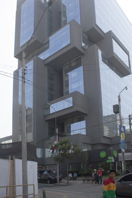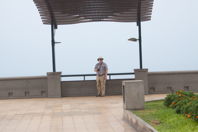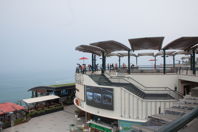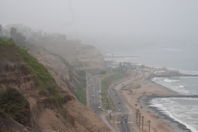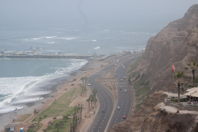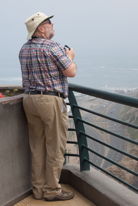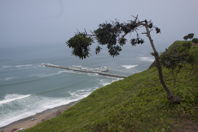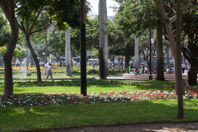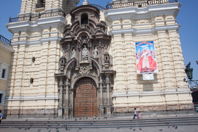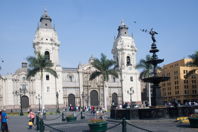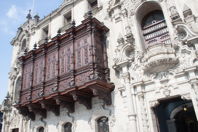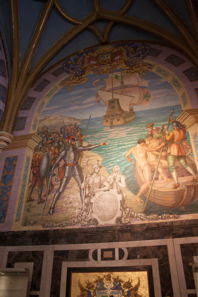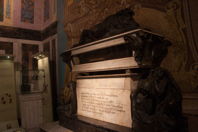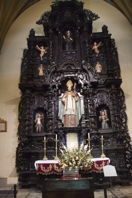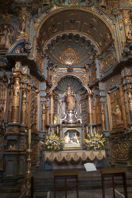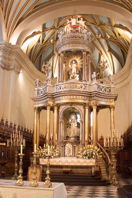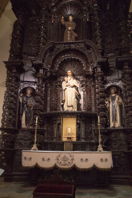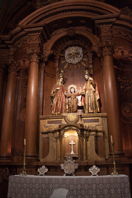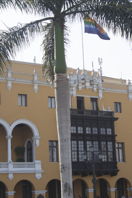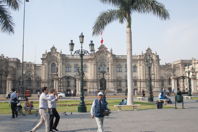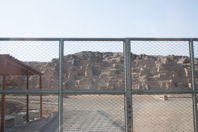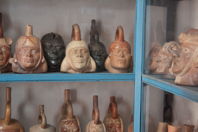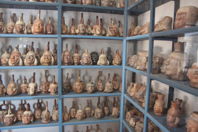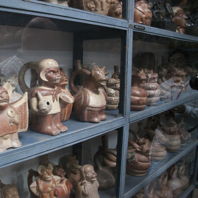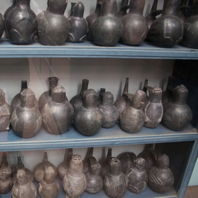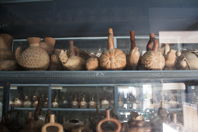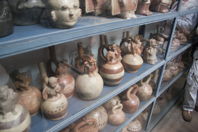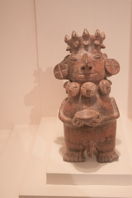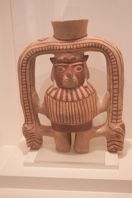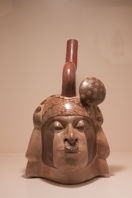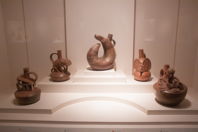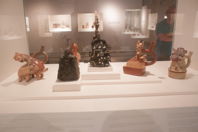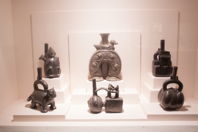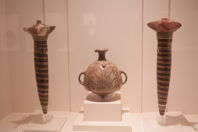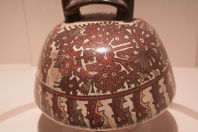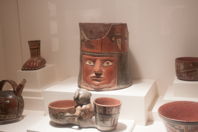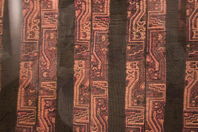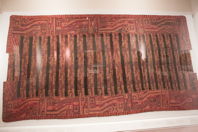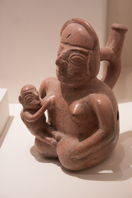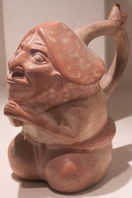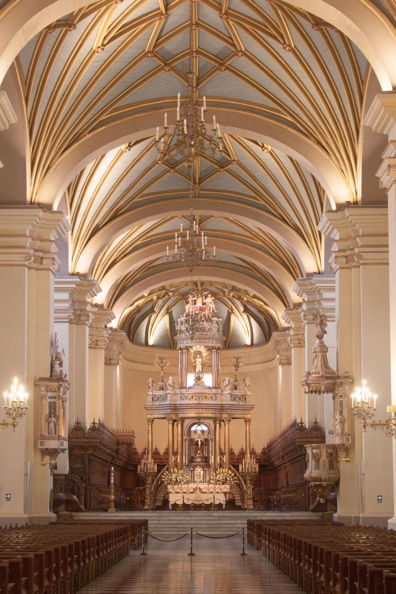
|
| The nave of the Lima Cathedral |
Tuesday, April 14, first day of the trip
Lima
We woke up after a good sleep in our fancy room, and went down to breakfast, which my journal says was «fairly Gringo-standard, except for the red beans, with pork floating in.» Mostly, in Perú, it seemed to me that the breakfasts were a bit less imaginative than I would have liked. Maybe I was just hoping for smoked fish?
Anyway, I should have said something about our hotel itself, the Casa Andina Private Collection Miraflores. The words “Private Collection” were always in English, and for the life of me I could not imagine what those words would mean to a Peruvian. The hotel is modern, clean, and suitable for an international businessman with a large expense account. But without all that much character. We would contrast this hotel of the chain with the similarly-named hotel in Cusco, which oozed character and local flavor.
After breakfast, we went out walking. Quoting from my journal, «Our route to the ocean was nearly southward, Avenida José Larco. It ends in a little park with a monument to a national hero. Miraflores, our submunicipality within Lima, is on a high bluff that rises from the beach. From the park, one could look out through a light haze at the ocean, and down a flight or two of stairs to a chichi shopping mall that MTK pointed out reeked of San Diego. Beyond that, looking downwards, you saw an automobile expressway pretty much at the level of the beach. The beach itself didn’t look very broad to me, and my guess is that the tidal draw here is not extremely great.»
The bluff itself looked to be just dirt, not stone at all, and it was hard to see how Miraflores might not wash into the sea. But it turns out that Lima gets practically no rainfall, and it would seem that the locals are confident that there’s no danger, even from storms that might come up to splash ocean spray on the bluff. Anyone who had lived in California for fifteen years, as we had, would be nervous living so close to the edge.
The walk along the narrow park at the bluff’s edge was pleasant, and we turned back inland at a large depressed artery that fed into the coastal expressway. From the journal again: «We walked along the depressed road, till it came up and became Diagonal, and this street went alongside the Parque Kenedy (sic), which we entered to find a large population of CATS. These got memorialized heavily by Mister King with his camera.»
From there, back to our hotel. I think there was a tacit agreement between us that we would eat there rather than venture out into the unfamiliar city so soon. The lunch was fine, but perhaps undistinguished.
Then, at 2:00, we got picked up by our driver José Luis and our guide Floriano. My journal says, «In the van, Floriano pointed out all sorts of buildings from the colonial era (prior to Perú’s definitive independence in 1866), and then took us to the Franciscan Church, where unfortunately, photography was strictly and completely forbidden.
«It’s really a monastery, still with a few monks, and apparently much of the establishment still in use. Some of it was well maintained, in spite of the occasional destructive earthquake, but there were parts that were in serious disrepair. One fresco, in particular, was greatly harmed by the fall of the underlying plaster.
«Unfortunately, the Franciscans have already [at the time of writing the journal only a few hours after the event] smeared themselves into a blur in my memory, and since there are no photographs, there is no aide-mémoire to remedy my failure.
«One memory persists: the visit to the catacombs of the Franciscan Church. This was not nearly as grisly a sight or experience as I expected. Almost all the bones we saw were femurs, though at one point there were some skulls on display. The femurs were almost always disposed in herring-bone fashion, very artistic. But where were the humeruses, the pelvises, the clavicles, the scapulas? Not to mention the ribs, vertebrae, the fingerbones.» This was a mystery we did not hear the solution to.
The next sights involved walking a short distance to the Plaza de Armas, which I guess must count as the town-hall square in a Spanish-colonial city. Facing the Plaza were the Cathedral, the Archbishop’s Palace, and the City Hall. And lots of other buildings as well, naturally. Clearly the fanciest folk in town would want their windows to look out on the Plaza de Armas. And it seems, as well, that a pleasing conspicuous display would be to have an ornate balcony on your house, constructed of exotic wood, as at right.
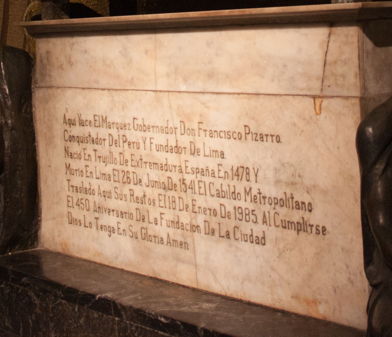
The Peruvians are worse than ambivalent in their regard for Pizarro, the Conqueror. Nonetheless, the first chapel we passed by as we entered the Cathedral was dedicated to him and his tomb. You can read the inscription that you see to the right better in the somewhat larger version. It starts, “Here lies…”, and ends, if I’m correct in seeing the last verb as a subjunctive, “May God hold him in His glory.” As you see from the date, the bones were placed there only in 1985.
This was hardly the only chapel in the Cathedral. All were ornate, in the Spanish style, and the pictures here give only a sampling. But in the block of five below, note especially the fourth one, of the Madonna and Child, with its abundance of elaborate wood-carving. You may be able to appreciate it even better in the larger version.
We emerged to the full light of the equatorial sun, hardly diminished at 3:30pm, as Floriano pointed out various buildings facing the Plaza de Armas. Among them was City Hall, flying what we assumed was the Rainbow Flag. This was a bit surprising to us, since throughout our Perú visit, we were asked over and over again whether we were brothers, or whether maybe Mark was my son. Anyway, by far the most impressive of the nonecclesiastical buildings was the Government Palace; the first such was built by Pizarro himself, but it’s been rebuilt and restored multiple times since. The current building reflects the taste of the mid-30’s, when it was completed.
The big tourist experience of the day was our visit to the Museo Larco Herrera, a collection that started out as a private endeavor but which is much more than that today. The Larcos, father and son, amassed a huge store of not merely pre-Columbian but pre-Inca artifacts, and there they are for you to admire, should you get to Lima.
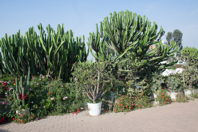
Entering the Larco; besides what
you see, loads of Bougainvillea
(big image, small).
Before we got to the Larco, though, Floriano and José Luis drove us past a huge archeological pile, I’m sorry I didn’t catch the description, but I think it was from one of the pre-ceramic cultures, that is, before about 1500BCE. You see it to the right. It’s the site of active excavation, so naturally it’s behind chain-link and inaccessible.
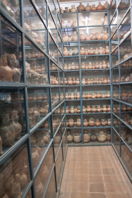
We got to the Museum, and found a beautiful low building, luxuriantly planted, with the Bougainvillea alone seeming to be in more colors than I had ever noticed in southern California. For whatever reason, Floriano led us not to the main display rooms of the Museum, but to what Mark and I think of as the storerooms of the establishment. Held in glass cases, thousands of ceramic pieces presented themselves. Many different styles, that is, from many different periods and cultures. The picture to the right looks like hoarding, doesn’t it?
The cases did not have their own lighting: it was just by room lighting that we saw the contents. As a result, there were reflections everywhere, and the photographs show it. If I had known, I would have brought a polarizing filter to minimize the reflections off the glass. Too bad!
But just look at the pictures to the left! (And please don’t depend on the thumbnails.) Look at the individualization of the portraiture in the top left of that block of six. Even if they are fictionalized faces, each one is entirely different from the others. Or look at the fancifulness of the animals in the middle row left and the bottom row right. The basaltware vases (as I suppose them to be) in the middle row right are not so varied, but still, the individuality of design in each one stands out. And how about the squashes bottom row left? To me they’re most delightful. Just think of what was happening in Europe in the same period, if these were done around the year +300. Nothing as imaginative or interesting or as finely finished. This stuff is terrific.
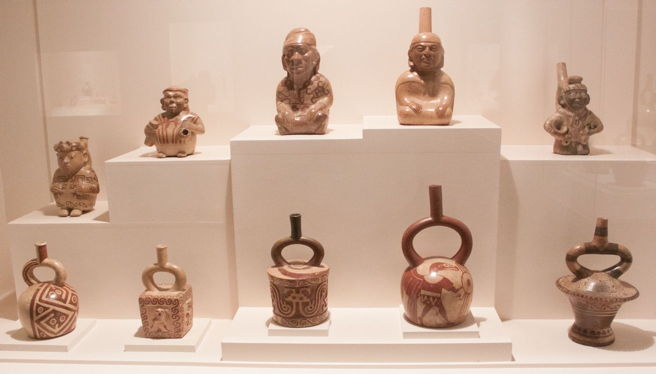
|
| Ten terrific pieces in the main museum. Click for a bigger view. |
But wait! Those were just the views of the “Storage Rooms”. Still to be seen were all the regular displays, carefully and professionally lighted and arranged. Where the best, rarest, beautifullest pieces were being shown. Like the ten pieces above. I can give only a sampling, completely insufficient to showing the wealth of variety and value in this little museum. In the top row of the block to the right, the leftmost is obviously much older than the others. The next one is newer, I’m sure, but what is that person doing with those snakes? And the third, a polished representation of somebody who had to be truly important, maybe the best example of the sophisticated style of many of the most interesting pieces in the Storage Rooms. In the bottom row, two pictures of showcases with multiple pieces; I liked the playing animals—dogs?—at the extreme left of the right-hand picture.
So many things, and so interesting. I went crazy taking pictures in the Museo Larco. Like in the top row to the right: left picture, they are receptacles all right, but how would they be used? For keeping holly or sacramental liquids of some kind? You certainly wouldn’t drink out of something like that, after all. To the right of that, those are certainly clubs, and somehow I recall being told that such things were weapons of war. In the second row, I just liked the decoration on that vase, or flask, or whatever it is; the objects in the right-hand picture are all interesting, but especially the beaker in form of human foot up at the left.
Finally, a couple of the few pieces of fabric that have made the trip of ten or so centuries. They’re of cotton, I believe. But important for showing the skill that those folks had.
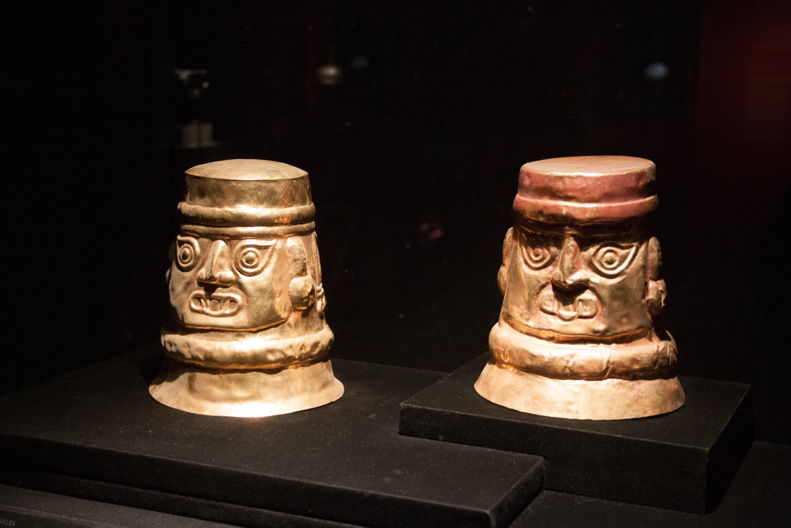
|
|
There were plenty of works in metal on display as well, but for some reason it was
the ceramic things that took my fancy. I find these things rather puzzling. Unlike the ceramic goods, there is no pretense of utility. You can see a much larger version as well. |
Our last stop within the Museo Larco was at a separate gallery devoted to erotic works. Many of the pieces shown there were in fact not particularly sexual in nature, just showing basic things like mothers suckling their child. But Floriano told us we should go in there without him. Why? We wondered whether he was embarrassed to go there; or whether he thought we would be embarrassed to have him with us; or what. We never found out.
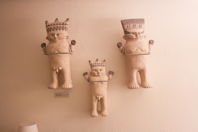
Yet, truly erotic subjects there were, some rather surprising. In general, lots of depictions of conjugal relations, and more of fellatio than I would have expected. Just two are shown here, a rather charming Mother and Child, and a very skillful and even humorous Phallus. I like the little man’s facial expression, best seen on either of the larger versions.
Along similar lines, on our hotel wall were mounted three ceramic reproductions, a family group of sorts, which seemed to be available for sale wherever tourists could be found. There they are, over to the right.
For the rest of the day, no more touristing. My journal says, «From there, a drive back to our hotel, where we had a rather nice dinner. I chose roast alpaca, which was properly cooked, and not at all tough.» The journal doesn’t even bother mentioning Pisco Sour: by now it would go without saying. After dinner, bed, and dreams of the next day’s adventures.

|
| A panorama taken in the morning in the little park at the end of the Avenida Larco. The haze-obscured ocean is beyond. |
